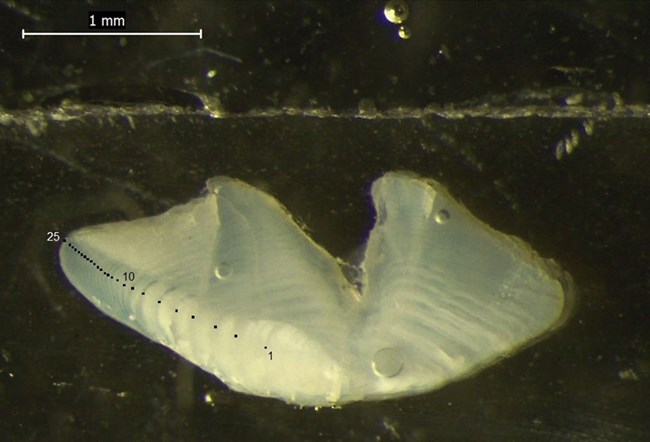Last updated: August 19, 2020
Article
Lake Trout Grow Faster as Spring gets Warmer

The width of annual growth rings (marked in the photo, from 1 to 25), provides a proxy for the growth rates of individual fish, and often production of the species and the ecosystem on which they depend.
A recently published study used otoliths to understand the response of lake trout to long-term warming in Lake Clark National Park and Preserve in southwest Alaska. According to the study, warmer springs, earlier lake ice break-ups, and longer ice-free seasons were related to faster lake trout growth. This relationship supports the results of other studies that link warmer water temperature and earlier lake ice break‐up to increased zooplankton production in southwest Alaska lakes. Together, these findings suggest that climate-driven increases in production at low trophic levels move up through the food web, where they benefit top predators like lake trout. However, the relationship between warmer temperature and faster growth may break down as warming accelerates beyond the historical range in this region.
Lake trout growth is sensitive to spring temperature in southwest Alaska lakes
Abstract
In high‐latitude lakes, air temperature is an important driver of ice cover thickness and duration, which in turn influence water temperature and primary production supporting lake consumers and predators. In lieu of multidecadal observational records necessary to assess the response of lakes to long‐term warming, we used otolith‐based growth records from a long‐lived resident lake fish, lake trout (Salvelinus namaycush), as a proxy for production. Lake trout were collected from seven deep, oligotrophic lakes in Lake Clark National Park and Preserve on in southwest Alaska that varied in the presence of marine‐derived nutrients (MDN) from anadromous sockeye salmon (Oncorhynchus nerka). Linear mixed‐effects models were used to partition variation in lake trout growth by age and calendar‐year and model comparisons tested for a mean increase in lake trout growth with sockeye salmon presence. Year effects from the best mixed‐effects model were subsequently compared to indices of temperature, lake ice, and regional indices of sockeye salmon escapement. A strong positive correlation between annual lake trout growth and temperature suggested that warmer springs, earlier lake ice break‐up, and a longer ice‐free growing season increase lake trout growth via previously identified bottom‐up increases in production with warming. Accounting for differences in the presence or annual escapement of sockeye salmon with available data did not improve model fit. Collectively with other studies, the results suggest that productivity of subarctic lakes has benefitted from warming spring temperatures and that temperature can synchronise otolith growth across lakes with and without sockeye salmon MDN.
von Biela, V. R., B. A. Black, D. B. Young, P. van der Sleen, K. K. Bartz, and C. E. Zimmerman. 2020. Lake trout growth is sensitive to spring temperature in southwest Alaska lakes. Ecology of Freshwater Fish.
